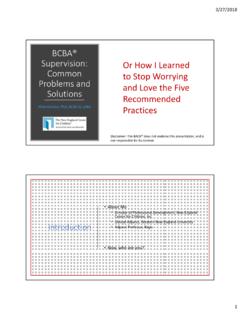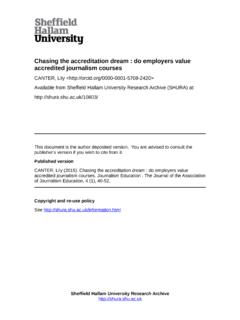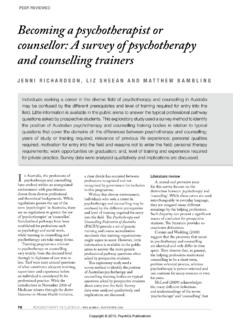Transcription of Ethical PerspectiveFINAL CLEAN
1 Ethical PERSPECTIVE Dementia: stigma and its effects Susan Mary Benbow1 & David Jolley2 1. Professor of Mental Health & Ageing, Centre for Ageing & Mental Health, Staffordshire University, and Director, Older Mind Matters Ltd. 2. Consultant Psychiatrist and Honorary Reader Manchester University. * Address for correspondence: Prof Susan M Benbow, Centre for Ageing & Mental Health, Faculty of Health & Sciences, Staffordshire University, Blackheath Lane, Stafford ST18 0AD. Email: Phone: 07789 485435 Office Phone: 01785 353742 1 Practice Points Clinicians should be aware of and resist the tendency to diminish, devalue and socially exclude people living with a dementia. The avoidance of people who are not like me', namely old and mentally slow, can result in neglect, lack of kindness and social exclusion. People with dementia should be supported remain involved in society and to express their thoughts, feelings and views.
2 Family and professional carers of people with dementia are valuable individuals who have voices which should be heard and respected. Although there is no cure for dementia in most instances, there is much which can be done to influence how people live with it by informed, intelligent good practice. Services designed to care for (older) people living with multiple physical and mental disorders including dementia, will serve others well too. The Nuffield Council Ethical framework for dementia can be used to inform Ethical decision- . making. Key words Dementia; discrimination; ethics; social exclusion; information; personhood; policy; research; service design; stigma. Summary In this article we reflect on stigma and the evidence about its effect on the care of people and families living with a dementia. We argue that it distorts services at all levels from people making the decision about seeking help, through those commissioning, designing and providing services, to politicians deciding about priorities and resources.
3 We conclude that Ethical non- stigmatising care focuses on personhood and relational aspects of care, and that work to reduce stigma is needed in four main areas: policy, research, information/ education, and service design/ delivery. Dementia is not something that affects other people it will impact on many of us as we grow older. People living with a dementia must be heard and respected. 2 In this article we look at some of the literature on stigma and dementia. We reflect on what we understand by stigma and the evidence regarding its influence on people and families living with a dementia and the services provided for them. What do we know about stigma and dementia? Whilst there may be broad agreement on what stigma means [1], it is a concept which has been defined in a number of ways and lacks an agreed operational definition: some authors regard it as synonymous with negative opinions [2].
4 Others have operationalised it in terms of social distance [3], but then concluded that an operational definition needs to include additional measures which draw on other aspects of stigma. A consensus statement [4] included the following under definition: Stigma results from a process whereby certain individuals and groups are unjustifiably rendered shameful, excluded and discriminated against.' (page 672) An alternative definition of stigma was used by the Alzheimer's Society: having some form of mark or sign that denotes disgrace or discredit'. [5] Stigma has been seen as including three aspects, namely stereotypes, prejudice and discrimination. Stereotypes describe collective judgements about groups of people eg people with dementia; prejudice refers to emotional reactions to a stereotyped person; and discrimination refers to behaviours which are associated with prejudice, including avoidance, coercion and segregation [6].
5 Werner and Giveon interviewed family physicians in Israel and found them to score highly on avoidance (eg reluctance to socialise with a person living with a dementia) and coercion (eg reporting that they would compel the person with a dementia to take drug treatments). They found anger- fear and pity were associated with tendency to discriminate: their paper is an example of one method of investigating stigma, in this case by operationalising discriminatory behaviour. It is also an example of evidence of stigma in healthcare professionals. Another factor in stigma is power differential, which can be regarded as an essential component of stigma [7]. A study of stigma in immigrant Chinese and Vietnamese carers used a different approach: stigma was operationalized using five evidential themes: negative labels eg crazy'; discrediting stereotypes' eg second childhood; negative emotional and social responses'; loss of status or discrimination'; and other [7].
6 Milne argues that people with dementia have to live with the combined impact of the dementia illness plus negative responses to the diagnosis and the symptoms of dementia (which includes the use of negative language), together with self- stigmatisation'; and that relatives are subject to secondary stigma' [8]. Milne also notes that age discrimination is an additional factor since dementia is an illness of later life, and that age discrimination accentuates the role of stigma. This has been called double jeopardy' [9]. Milne's secondary stigma has been called stigma by association [10, 11] or courtesy stigma', as Goffman described it as stigma courtesy' of a link with people who are subject to stigma [7] we might argue that this stigma extends to staff working in dementia services as well as the families of people with a dementia.
7 Secondary stigma influences how staff working in dementia services are under- valued in comparison with staff working in other areas of health and social care: this is 3 supported by work showing that the social workforce is less qualified and less likely to be working towards any qualifications [12]. Findings such as these explain the All- Party Parliamentary Group on Dementia's [13], conclusions in their report on the dementia skills gap: the workforce is perceived to have an inappropriately low status that is exemplified by poor employment terms and conditions and lack of career opportunities. This contributes to a high staff turnover, which militates against workforce development and acts as a huge disincentive to employer ' (page xi) Another categorisation of stigma includes three categories of stigma experienced by family carers of people with a dementia, namely caregiver stigma, lay public stigma and structural stigma [14]: public stigma is defined as referring to the reactions of lay persons to the stigmatised person; structural stigma encompasses service availability and inadequate professional competence'.
8 The latter category of stigma is exemplified by the lack of training of the dementia workforce [12] and under- . resourcing of research into dementia [15]. A consensus paper on reducing stigma and discrimination in older people with mental disorders [4] highlighted several important factors in stigma which the authors argue are related to dementia: Dementia being seen not as arising from illness but instead as an inevitable part of ageing (which leads to the belief that it can't be treated, and is an inappropriate area for highly skilled medical and nursing attention); Popular misuse of the term dementia'/ demented'; The assumption that people with a dementia have no quality of life and no capacity for pleasure; The exclusion of people by virtue of a diagnosis of dementia from some forms of care or treatment eg resuscitation; rehabilitation; Loss of personhood' which results in personal preferences and beliefs being dismissed.
9 Some symptoms are particularly stigmatising eg incontinence; disturbed behaviour. What do we know about how stigma affects the care of people with a dementia? Across European Union countries stigma has been found to influence late presentation to services (through the minimisation and concealment of symptoms), delays in recognition and diagnosis after presentation (through the belief that services had little to offer), and service response to dementia (through therapeutic nihilism and pessimism regarding prognosis) [16]. To this list we can add attitudes to screening [17]; a reluctance on behalf of medical professionals to give the diagnosis perhaps because of the stigma associated with it [18, 19]; an influence on service design so as to separate people with dementia from others [20] (some cultures find the acceptance of care to be inherently stigmatising [21]); and an influence on service resourcing and prioritisation such that care of people with dementia struggles to achieve parity with other services [22, 23].
10 These factors probably underlie objective 1 of the English National Dementia Strategy [24] states: Public and professional awareness and understanding of dementia to be improved and the stigma associated with it addressed'. (page 24) 4 The Strategy states that the stigma associated with dementia makes it more difficult to talk about, and that this contributes to delay in diagnosis and to the low priority given to dementia care services (we might add here that it also contributes to the low status of staff working in dementia care services [12, 13]). The Alzheimer's Society investigated the experiences of people with dementia and their families in 2008 [5] by holding a series of focus groups involving people recruited by branches of the Society plus carrying out a small number of interviews: they concluded that The stigma of dementia was very pervasive.





